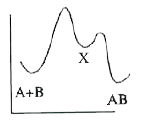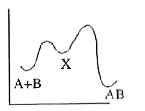The process 2A+B→C taking place in two steps:
1:2A→D 2:D+B→C(slow)
then rate of reaction gets Solution in Telugu



All are correct
The correct Answer is:B
Step by step video, text & image solution for The process 2A + B to C taking place in two steps: 1:2A to D" " 2: D + B to C(slow) then rate of reaction gets by Chemistry experts to help you in doubts & scoring excellent marks in Class 12 exams.
Topper's Solved these Questions
- BOOK - AAKASH SERIESCHAPTER - CHEMICAL KINETICSEXERCISE - Objective Exercise - 293videos
CHEMICAL KINETICS
- BOOK - AAKASH SERIESCHAPTER - CHEMICAL KINETICSEXERCISE - Objective Exercise - 3 (Previous NEET/AIPMT Questions)32videos
CHEMICAL KINETICS
- BOOK - AAKASH SERIESCHAPTER - CHEMICAL KINETICSEXERCISE - Subjective Exercise-4 (Numerical Problems)7videos
CHEMICAL KINETICS
- BOOK - AAKASH SERIESCHAPTER - CHEMICAL KINETCSEXERCISE - EXERCISE - 3.245videos
CHEMICAL KINETCS
- BOOK - AAKASH SERIESCHAPTER - CHEMICAL THERMODYNAMICSEXERCISE - Additional Practice Exercise54videos
CHEMICAL THERMODYNAMICS
Similar Questions
Consider the following reaction N2(g)+3H2(g)→2NH3(g). The rate of the reaction in terms in terms of N2 at T(k) is −d[N2]dt=0.02 mole lit−1sec−1. What is the value of −d[H2]dt (in mole lit−1sec−1) at the same temperature?
02:30View SolutionFor a first order reaction A→B the reaction rate at reactant concetration of 0.01 M is found to be 2.0×10−5mol L−1s−1. The half life period of the reactionis
02:15View SolutionThe initial concentration of [A] = 0.3 mol/lit. The concentration after 2.3 min is 0.15 moles/lit. What is the value of rate constant.
02:58View SolutionDiscuss on the kinetic spontaneity of a chemical reaction. Is a slow reaction spontaneous? Why?
01:19View SolutionWhich among the following is not an exact differential?
03:05View SolutionΔ=∣∣ ∣ ∣∣aa2012a+b(a+b)012a+3b∣∣ ∣ ∣∣ is divisible by a+b b. a+2b c. 2a+3b d. a2
View SolutionThe value of determinant ∣∣bc−a2ac−b2ab−c2ac−b2ab−c2bc−a2ab−c2bc−a2ac−b2∣∣ is a. always positive b. always negative c. always zero d. cannot say anything
04:07View SolutionThe mechanism for the overall reaction is A_(2) + B rarr C A_(2) rarr 2A (slow) 2A + B rarr X (fast) If a catalyst D changes the mechanism to A_(2) + D rarr A_(2) D (slow) A_(2) D rArr 2A+D (fast) 2A +B rarr C (fast) Which is the rate expresison for the reaction with and without a catalyst ?
01:19View SolutionFor the reaction, 2A+B→C+D, the order of reaction is
02:57View SolutionThe reaction 2A +B to B to D + E involves the mechanism , A to B (fast) B to C (slow) A+C to D +E the rate expressio would be ,
02:23View SolutionStatement-1: For the reaction 2A +B to C , the rate of disappearance of A is twice the rate of disappearance of A is twice the rate of disappearance of B. Statement-2: For the reaction : 2A +B to C Rate of reactions is (d[C])/(dt)
01:18View Solutiona,b,c और d के मान ज्ञात करे , यदि
[2a+ca−b3c+d2a−b]=[5−1130]01:40View SolutionFor the reaction, 2A + B to C + D , the order of reaction is
05:16View SolutionReactions: 2A+B+2C→D follows three mechanistic steps: 2A+B→X(slow) X+C→Y (fast) Y+C→D (fast)
What is the molecularity of the rate determining step and the total order of the reaction?01:36View Solution2A + B to D +E , for the reaction proposed mechanism A + B to C +D (slow), A + C to E (fast). The rate law expression for the reaction is
02:05View Solutionअभिक्रिया 2A+B→C+D के लिए, अभिक्रिया की कोटि है
03:48View Solution

